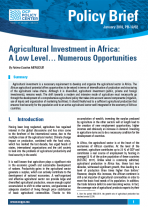Agricultural Investment in Africa: A Low Level… Numerous Opportunities
Agricultural investment is a necessary requirement to develop and organize the agricultural sector in Africa. The African agricultural potential offers opportunities to be seized in terms of intensification of production and structuring of the agricultural value chains. Although it is diversified, agricultural investment (public, private and foreign investments), remains weak. The shift towards a modern and intensive mode of agriculture must necessarily go through the development of a comprehensive agricultural policy that takes into account several components (irrigation, use of inputs and organization of marketing facilities). It should finally lead to a sufficient agricultural production that ensure food security for the population and to an active agricultural sector well integrated in the economy of African countries.
1. Introduction
Having been long neglected, agriculture has regained interest in the global discussions and has since come to the forefront of the international scene, due to the multiple crises of the agricultural market. Climate change impact on production, combined with the food crisis, which has marked the last decade, has urged heads of states, international organizations and the civil society to look into the problems of agricultural productivity and food security in the world.
It is well known that agriculture plays a significant role in the economic growth and sustainable development of nations. Productivity gains in the agricultural sector generate a surplus, which can actively contribute to the development of national economies. A well-organized and effective agricultural sector can provide large and diversified agricultural production, ensure enough capital accumulation to shift to other sectors, and guarantee an adequate standard of living through price stabilization of basic agricultural commodities. Thanks to this accumulation of wealth, investing the surplus produced by agriculture in the other sectors will at length lead to the creation of new employment opportunities, higher incomes and obviously an increase in demand. Investing in agriculture turns out to be a necessary condition for the development of countries.
In Africa, the agricultural sector is at the heart of the economies of African countries. At the level of the continent, agriculture contributes up to 23 % of GDP and constitutes a real source of employment by hosting in average 55 % of the active population of these countries (ILOSTAT, 2017). Unlike what is commonly admitted, agricultural production in Africa has, these last two decades, witnessed significant growth, thus leading to a level of production three times higher than before . However, despite this increase, the African continent is still a net importer of agricultural commodities in order to meet the basic food needs of its population. In addition, the trade balance deficit is even becoming worse. In fact, the coverage rate of agricultural products exports by their imports was 102 % in 1995 and dropped to 77 % in 2015. African countries moved from the position of surplus countries in terms of agricultural products to deficit countries and net importers of agricultural produce. Under such circumstances and in light of the increase of food prices and their volatility on the international market, in addition to the negative effects of climate events on agricultural production, African states should no longer count on imports to feed their population and are obliged to develop their agricultural sector to guarantee food security for their population and fight poverty.
As most of their population is rural, and agriculture is the most important activity African countries must necessarily invest in agriculture to reduce their food dependence on the international market, ensure food security and guarantee the creation of increasing wealth by making agriculture the driving force of growth of their economies.
2. Basic notions: expenditures and/or investment
By definition, investment consists of all expenditures aimed at increasing the productive capacity of a business. It seeks to acquire assets, which yield productivity gains spread over time. In agriculture, investment may take different forms. It consists in acquiring agricultural lands, planting of arboricultural orchards, purchasing livestock or agricultural equipment (machinery, equipment, buildings, etc.). From a microeconomic point of view – by reasoning as an economic agent – the purchase of a land is considered as an investment for a farmer, because this operation will enable him to increase his land holdings. However, from a macroeconomic perspective, this operation does not at all mean an increase of the country’s production capacity, because it is merely a change of owner and not the acquisition of a new asset. In this regard, spending on stone removal activities or on cultivation of grazing lands is considered as investment expenditure for the country because both activities contribute to increasing the production capacity of society.
In addition, while examining the pattern of expenditure, which can be classified under the investment expenditure account, another aspect needs to be clarified. It is the distinction between investment and operating expenditure. Such a distinction primarily depends on the notion of the cost-effectiveness of investment. Time plays an important part in the classification of expenditures. The costs of seeds, plant protection products and energy consumption are all profitable during the current year and are considered as operating expenditures. The costs of purchasing equipment, planting trees and purchasing – or the birth – of livestock (the latter will only become productive after a determined period) are considered as investment expenditures. The purchase of fertilizers may also be considered as operating and/or investment expenditure. In the short term, the fact of using fertilizers to improve crop yields is an operating expenditure because it is cost-effective within the same year. On the other hand, using fertilizers also allows to restore soil quality in the long run, this action may only become cost-effective in the long term and can be classified as an investment expenditure.
The concept of investment is very difficult to understand and the perception of an expenditure as an investment depends on several criteria, namely time and from an economic perspective (macroeconomic or microeconomic).
3. Who invests?
Investors, whether they are public or private, national or foreign, invest in agriculture in order to increase production, diversify products, generate profits and create added value.
- Public investment :
The supply of public goods is an elementary condition to encourage and support private investment. Public expenditure allocated to rural areas should be adequate to provide public goods such as education, infrastructure and research. Public investment must complement private investment to improve agricultural productivity and increase productivity gains, eradicate hunger, increase farm incomes and reduce poverty. According to Fan and Saurkar (2006), public spending on research has a much more significant impact on economic growth and agricultural development than spending directly aimed at the agricultural sector. In fact, scientific research makes it possible to acquire technical and technological know-how that can result, over time, in improved production and substantial productivity gains. In addition, the results of this research go beyond the mere one-time effect on growth and have a multiplier effect on the entire economy.
Investment in education is also considered as an effective means to increase agricultural productivity gains. In fact, by educating the rural population, agricultural workers leave the rural world and thus contribute to improving labor productivity. In addition, thanks to education and vocational training, agricultural workers will become better trained and will conduct every agricultural operation more effectively and efficiently.
As to infrastructures, several studies have demonstrated the importance of rural infrastructures and road networks as a driver of comprehensive economic growth in rural areas (Mogues, 2011). In fact, they make it possible to develop agricultural value chains, ensure the storage and transport of foodstuffs, source from input markets and facilitate access to output markets. Because of the sensitive nature of agricultural products (perishable and difficult-to-store products), electrification, cold chains, roads, storage buildings and processing plants are necessary conditions for the development of value chains in Africa.
Being aware of the importance of public investment in agriculture and in order to operationalize their commitment towards the development of the agricultural sector, African states decided at the meeting of the African Union held in Maputo in 2003 to raise the share of public expenditures allocated to agriculture up to 10 % of their budget resources within 5 years. This decision is meant to support the will of African governments to develop the agricultural sector, improve agricultural productivity, ensure food security and guarantee sustainable and sustained economic growth. In this respect, several Declarations and Decisions have been made at numerous summits, namely:
- The 2004 Sirte Declaration on the Challenges of Implementing Integrated and Sustainable Development in Agriculture and Water;
- The 2007 Decision on the Special Summit of Abuja on Fertilizers;
- The 2007 Decision of Abuja on Food Security in Africa;
- The 2009 Sirte Declaration on Investing in Agricultural for Economic Growth and Food Security;
- The 2014 Malabo Declaration on Accelerated Growth and Transformation for Shared Prosperity and Improved Livelihoods;
At their last meeting, the heads of states insisted on renewing African countries’ commitment to improve finance for investment in agriculture (by meeting the 10 % target of public expenditures). They also express their willingness to support agricultural growth to at least 6 %, create employment opportunities for at least 30 % of youths in the agricultural value chains and of course promote women’s participation in the agricultural labor market. The following figure gives us an idea of the countries, which have succeeded to exceed the level of expenditures in agriculture agreed upon by the African Union Heads of States and Governments.
Figure 1: Share of expenditure in agriculture within total public expenditure in 2014
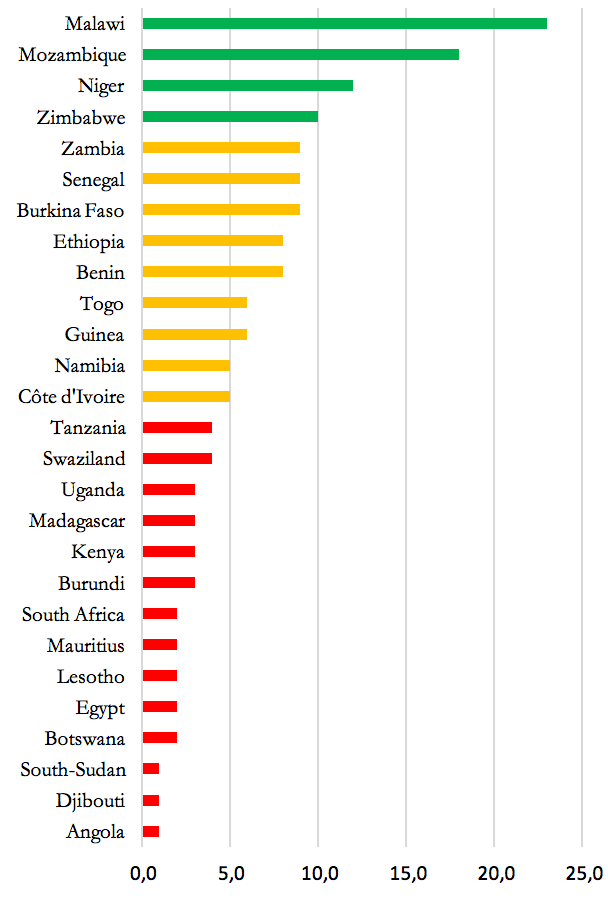
Source : FAO, 2017
According to Figure 1, in 2014, only four African countries exceeded the level of agricultural expenditures in the total public expenditures set by the African Union within the Maputo Declaration. These countries are: Malawi (23 %), Mozambique (18 %), Niger (12 %) and Zimbabwe (10 %).
On the other hand, nine African countries have seen the share of their public agricultural expenditure in total government expenditure vary between 5 % and 10 %. Yet, according to historical data we even notice a decrease in the share of agricultural expenditure in total government expenditure. In the case of Burkina Faso, the share of public expenditure allocated to the rural world dropped from 31 % in 1991 to 9 % in 2014. This observation applies to all the African countries which used to allocate much more significant shares to agriculture from Government budgets prior to the Maputo Declaration. Lastly, in 14 African countries, the share of public resources allocated to agriculture is below 5 %. This is the case of Tanzania (4 %), Egypt (2 %) and Angola (1 %) .
Figure 2: Agricultural Spending Index (Government expenditure) in 2014
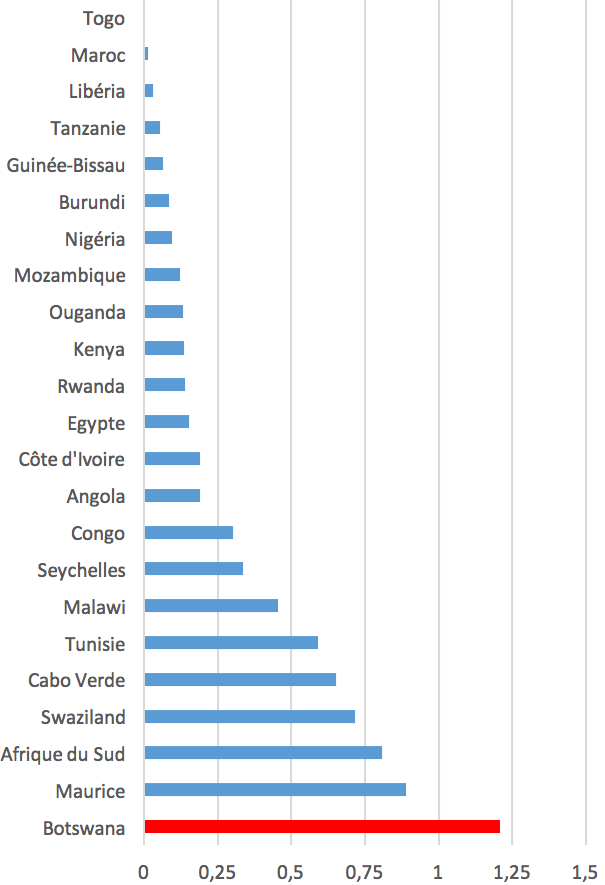
Source : FAO, 2017
The share of expenditure allocated to agriculture is not a good indicator that gives an idea of the importance of agriculture and of the efforts made by the government in terms of agricultural development. The agricultural spending index is an indicator based on the share of public expenditure allocated to agriculture in proportion to the contribution of agriculture to GDP. This indicator is above 1 when the government allocates large amounts for agricultural development regardless of the contribution of agriculture to the economy. In other words, when this index is above 1, this means that agriculture receives much higher public funds than its contribution to wealth creation.
The agricultural spending index of government expenditure shows that in Africa the amount of public funds allocated to agriculture is lower than the contribution of the agricultural sector to the GDP of the countries studied.
Only Botswana has an index above 1, which means that in this country, public funds allocated to the rural areas are higher than the wealth created by the sector.
In countries such as Mauritius, South Africa, Swaziland and Tunisia, it is clear that the government’s will puts agriculture at the heart of their economic development strategies. These countries have an agricultural spending index which varies between 0.9 and 0.6. Unlike this group of countries, Liberia, Morocco and Togo show the lowest index in Africa at 0.01. Efforts made by African governments remain inadequate.
- Private investment:
As the improvement of productivity to obtain maximum profit is the ultimate goal of any investment, private operators in the agricultural sector invest in order to acquire new and more effective tangible or intangible goods that replace obsolete goods and will thus increase productivity. As in the case of public investment, private sector agents (farmers, cooperatives or companies) may directly invest in the rural areas and launch agricultural projects. They can also direct their investment towards financing research and the creation of agricultural patents. In general, private investment can be defined as any expenditure made by the private sector with a view to participating in the formation of agricultural capital.
In general, it is very difficult to understand and quantify private investment. As such, funds released for financing investment come from two main sources. The first source is savings. Whether they are capital holders or just households, economic agents may save and invest these amounts to generate profits and create added value. The second source consists of bank loans. In fact, commercial banks may grant bank loans to entrepreneurs subject to several conditions. In agriculture, quantifying agricultural investment is a whole mystery that needs to be solved. Indeed, several difficulties arise when trying to calculate private investment in agriculture, especially in developing countries, and this is the case in 99 % of African countries.
Figure 3: Share of agriculture in total loans granted by commercial banks in 2015
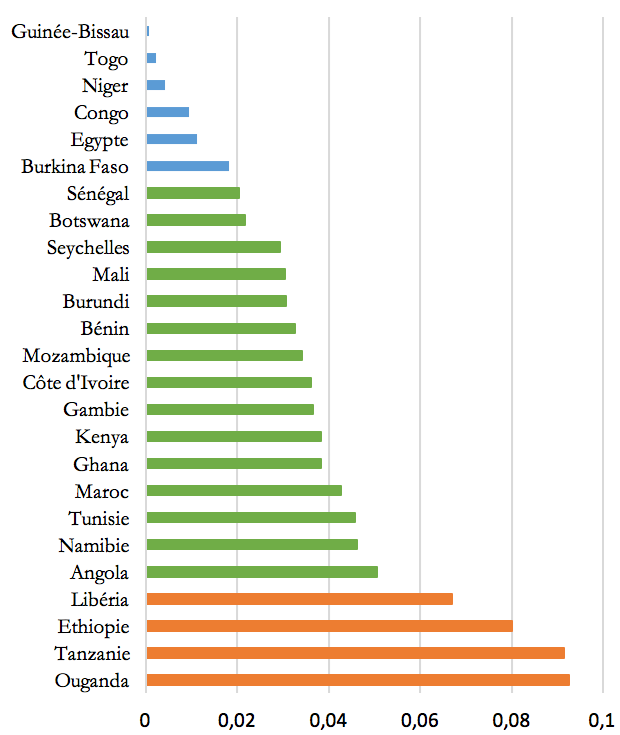
Source : FAO, 2017
In Africa, the agricultural sphere is characterized by the existence of a dual system: traditional and modern agriculture. In the traditional agriculture, only few farmers would use bank loans to finance their investment. Heads of farms are most often illiterate and finance their investment either by saving or by borrowing money from their family or their friends . In fact, this part of these transactions are not included in the calculations and are not captured at the macroeconomic level when it comes to estimating private investment funds intended for agriculture. In modern, intensive and capitalistic agriculture, entrepreneurs usually apply for loans with commercial banks, which makes easy to quantify and track agricultural investment flows. Measuring the share of loans intended for agriculture gives us an idea of the importance of this sector in the strategic vision of investors. In Africa, the proportion of bank loans intended for agriculture in total credits is small.
The proportion of loans granted by commercial banks to farmers in total credits in Africa varies between 0.06 % in Guinea-Bissau and 9.2% in Uganda and Tanzania. Morocco is one of the countries where bank loans intended for agriculture do not exceed 4% of total loans granted by banks. This low level in Africa may be explained by several reasons; first of all, by the problems of access to bank loans due to the absence of collaterals (land titles or other documents); then by the high interest rates applied to agriculture. In view of the fact that agriculture is subject to several hazards, namely the risks of delay or lack of rainfall, pest invasion, fungal diseases or even fluctuations of input and output prices, interest rates applied to farmers are often high and not accessible to small farmers. Furthermore, it should be noted that loans granted to farmers are not necessarily used in agricultural production activities. Like any other economic agents, farmers may borrow money and use it to finance other personal interests.
- Foreign direct investment
It is certainly difficult for African countries to make all the necessary investments at once by themselves to develop agriculture in Africa. The agricultural sector is often not well structured and requires a lot of funds for its restructuring. Loans and donations do certainly represent sources of finance; however, they are not permanent and entail many requirements that complicate access to this type of financing. In front of such complications, foreign direct investment may play a complementary role in these situations. In fact, FDI may boost agricultural development and help achieve sustained agricultural growth thanks to the implementation of agricultural projects that generate employment and agricultural added value. They may also facilitate the adoption of new technologies through imports of new techniques and agricultural production equipment.
Figure 4: Share of FDI inflow in agriculture by region
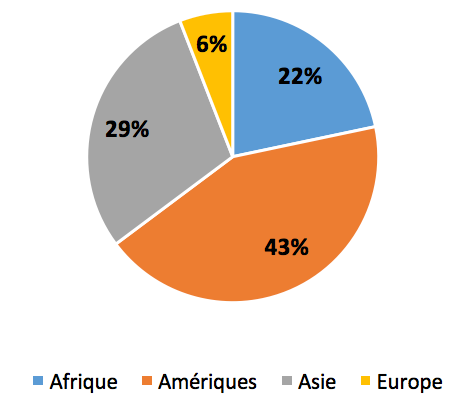
Source: FAO, 2017
In spite of Africa’s significant potential in terms of abundance of production factors (land, water and labor) and their relatively lower cost, this continent does not benefit much from foreign direct investment (FDI) and ranks third in terms of their inflow (22% in Africa versus 29% in America and 43% in Asia).
In addition, FDI inflows to Africa have increased at a rate of about 2.8 over the period 2001-2011. Their evolution shows that FDI flows intended for agriculture in Africa has achieved very rapid growth. In average, Africa has received about 260 million dollars through FDI over the period under study. Africa has a considerable potential as a host for FDI.
4. How to invest for a better agriculture in Africa?
To promote agriculture in Africa, there are different key components on which one must act, such as water control through irrigation, intensification by using selected seeds, fertilizers and mechanization and lastly organizing agricultural markets as well as agricultural value chains. This section features actions that African investors, whether public or private, national or foreign, should undertake to ensure a better agricultural production, both quantitatively and qualitatively.
- A better risk management through irrigation…
Water control is a necessary condition for intensifying and developing agriculture in Africa. African agro-ecological zones provide the agricultural sector with an important production potential from desert crops to tropical crops. However, due to the irregular nature of rainfall, particularly in conjunction with direct climate change impacts (temperature increase, irregularity and increasing scarcity of rainfall), we can say that agriculture in Africa cannot do without irrigation.
Africa has a total agricultural area of about 1.13 billion hectares, but only 15.6 million hectares are equipped for irrigation, i.e. about 1.4% of total African agricultural areas. Compared to other continents, Africa has the world’s lowest rate of irrigation equipment. In Central and South America and in Asia, for example, areas equipped for irrigation respectively amount to 23 million hectares and 1.6 billion hectares, i.e. about 3.1% and 15 % of total agricultural land. Nevertheless, before referring to the need for additional equipped areas in Africa, focus should be placed on the situation of areas already equipped for irrigation and which need to be rehabilitated. In Sub-Saharan Africa, out of the 6 million hectares which are already equipped for irrigation, 1 million hectares need to be rehabilitated. This need varies from one country to another. In Lesotho, all equipped areas should be rehabilitated (Liang, 2008).
Investment in irrigation is not just a matter of infrastructures. In fact, even in terms of land parcels, farmers must invest in irrigation with the assistance of the public authorities for more effective and efficient use of water. The use of new precision irrigation techniques, namely localized irrigation, will allow farmers to both ensure a better management, and hence a better valuation of irrigation water and provide the required quantities for the development of crops grown when they are actually needed. These practices will then generate higher yields and a better use and a more effective allocation of water.
From a policy perspective, an integrated water resources management program should be developed by the public authorities. Water is a vital resource used by several sectors including the supply of drinking water and the production of electricity. It is also used for industrial purposes, namely in food processing, mechanical and extractive industries. An effective and efficient water policy, which takes into consideration the context of increased scarcity of water and the multiple use of this resource should be implemented, through the use of several policy instruments including water pricing.
- An intensified agriculture adapted to the African environment
To date, Africa has little intensive agriculture. The use of inputs remains below the world average. For example, the average use of fertilizers in Africa revolves around 8 kg/ha whereas the world average amounts to 102 kg/ha. There is room for more action in terms of use of fertilizers. In this regard, investment has to be made at several levels. The government must offer the conditions necessary to supply and distribute fertilizers to the farmers. It has the obligation to provide farmers with permanent and regular physical and financial access to fertilizers through trade policies and price policies. In addition, it must make sure to put on the market fertilizers that are adapted to the local types of soils and crops, promote rational fertilization and support producers throughout the production process.
With respect to mechanization, the rate of mechanization in Africa is equally low. According to Fuglie, the stock of farm machinery converted to a power representation is only 700 thousand HP . The rate of mechanization per hectare in Africa revolves around 2.6 HP/ha versus 27.7 HP/ha in average at international level. In light of this situation, African states must invest in mechanization and benefit from the latest technologies in the field. This would facilitate the use of effective modern machinery and would therefore generate an increase in agricultural productivity. The seed sector should also be high on the priorities of African countries because the use of selected seeds is far below the world average.
- Adding value to products and organizing marketing channels
Agricultural development must necessarily go through the organization of agricultural value chains. In fact, it is not only a matter of increasing agricultural production through intensification, but also improving the whole agricultural sphere by acting on several components such as storage conditions, processing units, organizing intermediaries, marketing of products, etc. Agriculture in Africa offers numerous opportunities for investors in terms of organizing agricultural chains. Taking the example of processing food products by building upon local know-how, processing units could be constructed. In addition to producing food products that could ensure food security for the population, these units may generate more added value by creating employment and using domestic inputs. They will have a much higher multiplier effect since they will use domestic resources and will be better integrated into the local economy. In addition, the sensitive and perishable nature of food products is very demanding in terms of their packaging. Developing value chains requires a permanent access to electricity and cold storage facilities that should comply with wetness conditions; efficient routes must connect production areas with sales points, etc. Unfortunately, in Africa the infrastructure necessary for storage and packaging of agricultural products is still poor, even non-existent in some regions. Investment must be directed in such a way as to organize value chains for a better valuation of agricultural products.
- Better research and extension work for tomorrow’s agriculture
In theory, technological change is considered as an engine for economic growth (Solow, 1995). In a stationary state, there can be no growth without adopting new technologies capable of acting on productivity and increasing production. Research is a source of technological change and can be considered as a major leverage for changing production systems and modernizing the rural areas through productivity gains deriving from the use of the results of research. Research in agriculture has a wide potential, which can help mitigate the constraints and difficulties encountered by the agricultural sector. This type of research generates technological, sociological and economic innovations, which can be used by farmers to improve yields and increase production.
Taking the example of climate change, the temperature increase projected over the next decades will cause a drop in the yields of some crops in Africa. In addition, it is likely that these crops may no longer be adapted to the new environmental context and may disappear over time. The problem may be aggravated because it concerns staple crops such as wheat, maize, sorghum and millet. It is projected that, within the framework of the adverse impacts of climate change, temperatures should increase. Besides, exposure to global warming has an impact on the development cycle of crops and shortens the growing season, which in turn acts on biomass development and results in a loss of production (FAO, 1995). Based on projections, a temperature increase of 2° Celsius is expected to result in a decline in wheat yields by 10%. There is a risk that this will exacerbate the problem of food security in African countries and may weigh heavily on the bill of imported agricultural products. In front of all these challenges, it would be reasonable to invest in research on seeds and heat-resistant cultivars.
5. Conclusion
Agriculture in Africa has to cope with several constraints; first of all the impact of climate change which results in lower agricultural production. Then population growth that generates an increasingly higher demand for agricultural food products; and lastly the change in dietary habits which affects food production and directs it towards specific crops in accordance with the dietary intake patterns adopted by the population. In such circumstances, African countries can no longer count on imports and must necessarily restructure their agricultural sector so as to ensure food security for the population and reduce their dependence on the international market. To this end, African heads of states, aware of the magnitude of the problem, have developed several agricultural development programs and insisted on the importance of investment intended for agriculture so as to achieve sustained agricultural growth, meet their population’s food needs, create employment opportunities and lastly eradicate hunger and reduce poverty. To date, agricultural investment remains low. In spite of efforts made by the public authorities, the private sector and even by foreign investors, the agricultural potential in Africa is still under-exploited and offers considerable development opportunities. To achieve significant productivity gains within the agricultural sector, priority measures should be taken at different stages of production and along the agricultural value chains existing in the countries (intensification through irrigation, use of fertilizers and selected seeds, organizing sales and input supply channels, ensuring adequate infrastructure, etc.).










